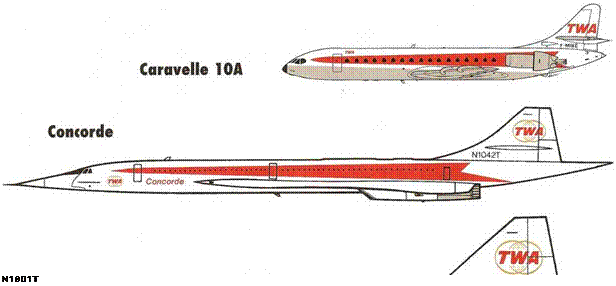SST and the Second Line

French Initiative
In 1952, in England, de Havilland and B. O.A. C., with the Comet, had demonstrated that a well-matched airframe and engine could combine to produce an efficient jet airliner. But just as until then, the aviation sages had warned that jet propulsion could not be applied commercially, they then claimed that, in spite of the Comet, jet airliners would be totally uneconomic for short-haul work. The world’s first short-haul jet, the twin-engined Sud-Est 210 (later the Sud Aviation Caravelle), proved that this was not so. The 210 had the proven Rolls-Royce Avon engines, and even the Comet nose; and surprised the designers all over the world by putting the engines at the rear of the fuselage. There were many advantages: the wing was left clear of protuberances such as engines—the ‘clean’ wing; they were easily accessible for maintenance; and their position substantially reduced the noise level in the cabin. Nevertheless, the idea was looked upon with skepticism, even scorn, in some aviation circles.
The First Short-Haul Jet
Sud-Est went ahead. The Caravelle made its maiden flight on 27 May 1955. Air France ordered twelve, and introduced it on the Paris-Istanbul route on 6 May 1959. By this time, 50 aircraft had been ordered, and eventually more than 250 were sold. In the United States, United Air Lines was the only customer and put it on the New York-Chicago route on 14 July 1961. T. W.A. ordered 20 Mark 10A “Nouvelle Caravelles” on 7 September, but cancelled the order in May 1962. The airline had already ordered ten Boeing 727s (see below and following pages.)
What Might Have Been
(the three drawings are on the same scale)
Boeing 2707
Supersonic Dreams
T. W. A.’s disregard for the 68-69-seat Caravelle—which would have given good service on much of the domestic route system where the traffic demand did not justify the larger jets—was in contrast with its enthusiasm for supersonic airliners. To be fair, it was not alone, as most of the world was queuing up to put down names on the Concorde and U. S. SST order books. On 14 October 1963, T. W.A. advised the
U. S. government of its intention to buy six Boeing SSTs, and deposited $600,000 with the Federal Aviation Agency (F. A.A.). The order was even increased to ten on 14 November 1963, and to 12 on 18 October 1967.
Hedging its bets, T. W.A. also ordered four Anglo – French Concordes, and increased this to six on 1 April 1964. The supersonic aspirations were always a dream, and were never supported by economic considerations. The T. W.A. management could not now blame Howard Hughes for this diversion from the main stream of equipment development, but at least it had taken care of the less exotic side of the business, with less spectacular operations.
The Third Level
The awareness of the need for aircraft to serve smaller cities and feeding into the trunk routes was prevejfant during the 1960s. The high interest in the hub principle had not yet developed. Aircraft such as the Caravelle, Boeing 727, and DC-9 fulfilled these needs, and supplemented the Boeing 707s and Convair 880s, often overlapping in their application and deployment. The Boeing 727 could fly coast-to – coast with only one stop. But below this Second Level was an even lower level of air service, sometimes referred to as the Third Level, or Scheduled Air Taxi, or, later, the Commuter. To protect this end of the travel market, T. W.A. made agreements in the early summer of 1965, with San Francisco Helicopter Airways (guaranteeing a break-even need) and with New York Airways (sharing financial support with Pan American). The following year, T. W.A. was associated with Piper Twinair, a small commuter airline in the New York area, which fed passengers into T. W.A.’s JFK terminal from neighboring communities.










